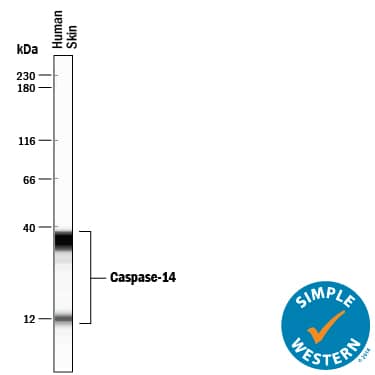Human Caspase-14 Antibody
R&D Systems, part of Bio-Techne | Catalog # MAB8215

Key Product Details
Species Reactivity
Applications
Label
Antibody Source
Product Specifications
Immunogen
Ser2-Gln242
Accession # P31944
Specificity
Clonality
Host
Isotype
Scientific Data Images for Human Caspase-14 Antibody
Detection of Human Caspase-14 by Western Blot.
Western blot shows lysates of human skin tissue. PVDF membrane was probed with 0.2 µg/mL of Mouse Anti-Human Caspase-14 Monoclonal Antibody (Catalog # MAB8215) followed by HRP-conjugated Anti-Mouse IgG Secondary Antibody (Catalog # HAF018). Specific bands were detected for full length Caspase-14 at approximately 28-30 kDa and the p10 subunit at approximately 10 kDa (as indicated). This experiment was conducted under reducing conditions and using Immunoblot Buffer Group 1.Caspase-14 in Human Epidermis.
Caspase-14 was detected in immersion fixed paraffin-embedded sections of human epidermis using Mouse Anti-Human Caspase-14 Monoclonal Antibody (Catalog # MAB8215) at 15 µg/mL overnight at 4 °C. Tissue was stained using the Anti-Mouse HRP-DAB Cell & Tissue Staining Kit (brown; Catalog # CTS002) and counterstained with hematoxylin (blue). Specific staining was localized to the nuclei of suprabasal keratinocytes. View our protocol for Chromogenic IHC Staining of Paraffin-embedded Tissue Sections.Detection of Human Caspase-14 by Simple WesternTM.
Simple Western lane view shows lysates of human skin tissue, loaded at 0.5 mg/mL. Specific bands were detected for full length Caspase-14 at approximately 36 kDa and the p10 subunit at approximately 12 kDa (as indicated) using 2 µg/mL of Mouse Anti-Human Caspase-14 Monoclonal Antibody (Catalog # MAB8215). This experiment was conducted under reducing conditions and using the 12-230 kDa separation system.Applications for Human Caspase-14 Antibody
Immunohistochemistry
Sample: Immersion fixed paraffin-embedded sections of human epidermis
Simple Western
Sample: Human skin tissue
Western Blot
Sample: Human skin tissue
Reviewed Applications
Read 2 reviews rated 5 using MAB8215 in the following applications:
Formulation, Preparation, and Storage
Purification
Reconstitution
Formulation
Shipping
Stability & Storage
- 12 months from date of receipt, -20 to -70 °C as supplied.
- 1 month, 2 to 8 °C under sterile conditions after reconstitution.
- 6 months, -20 to -70 °C under sterile conditions after reconstitution.
Background: Caspase-14
Caspase-14 belongs to the evolutionarily conserved caspase family of cysteinyl aspartate-specific proteinases that frequently play a central role in apoptosis. Caspases exist as inactive proenzymes that undergo proteolytic processing at conserved aspartic residues to produce large and small subunits that dimerize to form an active enzyme. Caspase-14 is processed to form p19 and p10 subunits, but unlike many caspases, this activation is believed to be non-apoptotic. Expressed within hair follicles and sebaceous glands in the epidermis, Caspase-14 processing is implicated in terminal keratinocyte differentiation and cornification. Caspase-14 expression may also protect against psoriasis and epidermal UVB photodamage. Full-length human Caspase-14 is 242 amino acids (aa) in length, and shares 71% and 72% aa sequence identity with mouse and rat Caspase-14, respectively.
Alternate Names
Gene Symbol
UniProt
Additional Caspase-14 Products
Product Documents for Human Caspase-14 Antibody
Product Specific Notices for Human Caspase-14 Antibody
For research use only


